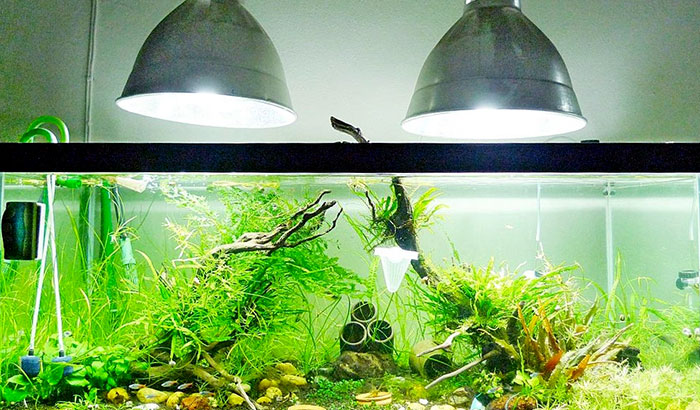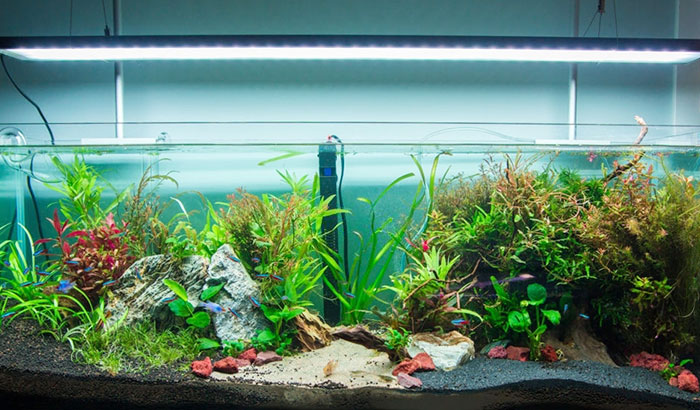If you have tried growing plants indoors, you might have heard of grow lights. And if you try growing those plants in an aquarium, then you might be conflicted as to whether to use an aquarium light instead of a grow light. This post focuses on aquarium light vs grow light.
Which of these lights is better to use for what purposes? Is an aquarium light better suited than a grow light in an aquarium setting? This post will answer these questions and more.
Contents
Aquarium Light vs. Grow Light – Tackling the Differences
There are four primary differences between aquarium light and grow light. These differences are plant growth sustainability, composition, color spectrum, and Kelvin rating. Let’s discuss these factors in-depth.
Plant Growth Sustainability
The most significant difference between the two indoor lights is their capability to help plants grow.
As you might have already surmised, the grow light can help plants grow. Grow light is specifically designed to help plants grow, while aquarium light is only meant to illuminate aquariums.
Grow light has unique features that are conducive to plant photosynthesis. Its light spectrum delivers wavelengths of light that plants can use for energy. On the other hand, aquarium light may damage plants if it is too hot or lacks the correct light spectrum.
Composition
Grow lights usually are comprised of several LED lights mounted within a single casing along with a heat sink and a fan assembly to prevent overheating. Grow lights have these features because most of them have adjustable light settings. Some setups need specific wavelengths or temperatures, which a grow light with multiple LEDs can provide.
Types of Grow Lights
The types of grow lights are HID (high-intensity discharge) light, T5 HO (high output) fluorescent lights, and LED grow lights.
HID lights have high-pressure sodium and metal halide lights. People typically use these types of lights in large and deep coral reef tanks because of their high-intensity output. They produce a lot of heat, so you need extraction equipment to remove the hot air.
T5 HO fluorescent lights are popular in planted home aquariums. They last long and are affordable, so they make for great options. Even though they produce lights intense enough for plant growth, they don’t create a lot of heat.
LED grow lights are the most environmentally friendly grow lights. They don’t consume much power but still produce a light spectrum similar to the sun’s rays. Furthermore, you can get them tailored specifically for your aquarium.
Types of Aquarium Lights
On the other hand, aquarium lights don’t have these complicated setups. Any light that can illuminate the inside of an aquarium will suffice as an aquarium light. The light may be LED or fluorescent; as long as it can light up an aquarium, it will suffice.
But aquarium lights are not that simple. Different aquariums may need unique kinds of aquarium lights. The different types of aquarium lights include LED, fluorescent, compact fluorescent, metal halides, and incandescent lights.
LED lights are the most popular form of aquarium light for various reasons. One reason is that they are highly affordable both initially and in the long run. They consume very minimal power and have a long lifespan. Plus, they don’t emit high temperatures, making them suitable for making the water in aquariums stable. You can adjust the light intensity with LED and have different colored options.
Standard fluorescent lights are good options because they require very little power and are pretty efficient. They come in different sizes and colors, so you have options. However, they are unsuitable for non-planted aquariums as they don’t produce intense lights.
Compact fluorescent lights are smaller but produce brighter lights than standard fluorescent lights. These lights can produce intense illumination depending on their wattage, so they can be suitable for planted aquariums. However, they also produce heat, so you would have to invest in an auxiliary fan.
Metal halides are more suitable for reef tanks because they produce high-intensity lights. They are powerful aquarium lights better suited for large and deep tanks. However, these lights make a ton of heat and are pretty expensive to maintain.
Incandescent lights became obsolete because they produce a lot of heat. They might be initially affordable, but they are inefficient and often need replacements.
Color Spectrum
Aquarium lights tend to produce a green aesthetic that looks good in an aquarium setting. You might also get an aquarium light with a bright white light that showcases the unique colors of your fish.
On the other hand, grow lights produce red and blue hues that promote plant growth.
Kelvin Rating
The Kelvin rating of a light source describes the warmth or coolness of its color. Aquarium lights have a Kelvin rating of 8000K or higher because they produce bright lights.
On the other hand, grow lights range between 4700K to 6700K that emulate the natural daylight color. Within this range, plants can photosynthesize.
Conclusion
The four primary differences between aquarium and grow lights are their capacity to foster plant growth, composition, color spectrum, and Kelvin rating. But in a nutshell, grow lights can help plants grow while aquarium lights illuminate an aquarium to display its beauty. You just have to remember that core difference the next time you think about aquarium light vs. grow light.


